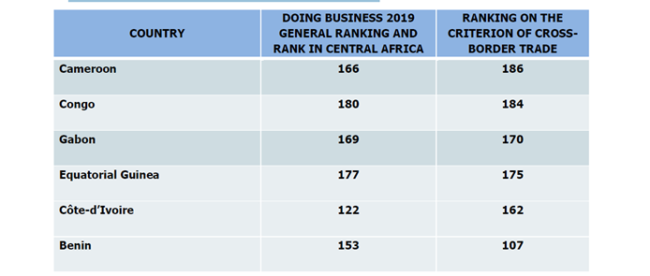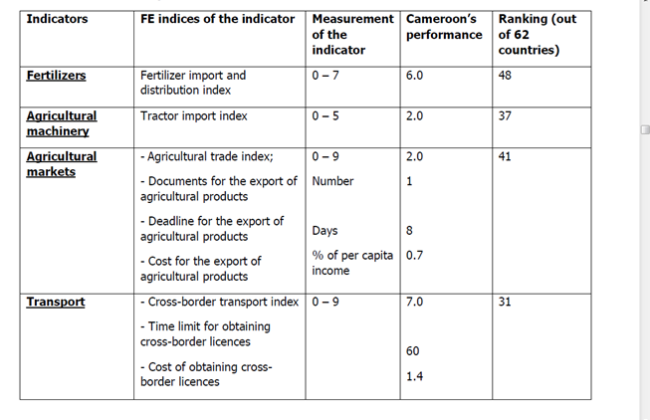The diagnosis presents Cameroon’s baseline situation and highlights some major concerns regarding the implementation of trade facilitation measures.
The diagnosis presents Cameroon’s baseline situation and highlights some major concerns regarding the implementation of trade facilitation measures.
I- BASELINE SITUATION
The analysis of Cameroon’s baseline situation is based on international indices and national
trade facilitation work.
1- Presentation of Cameroon’s ranking on international trade facilitation indices
Cameroon has embarked on a comprehensive trade facilitation reform programme by adopting several relevant measures at the legal, institutional and operational levels. However, international rankings and recent studies show that much remains to be done, especially in the area of cross-border trade, where delays and costs for imports and exports remain very high. To this end, Cameroon’s ranking in the various indices calls for a real review of the approaches used in trade facilitation.
The following developments analyse the current situation in order to describe a baseline for the future.
a – World Bank Doing Business Ranking (“Cross -Border Trade” Criterion)
- Content of the “Cross-border trade” Criterion of Doing Business:
Doing Business measures the time and costs associated with the logistics process of exporting and importing goods, including the time and costs (excluding customs duties and taxes) associated with meeting documentation requirements and complying with cross-border export and import trade procedures.
The case studies for imports take into account spare and containerised car parts (HS 8708), and for exports, the product for which the country has a comparative advantage (defined by the highest export value) to its natural partner, that is, the economy that is the largest buyer
- Content of the “Cross-border trade” Criterion of Doing Business:
Doing Business measures the time and costs associated with the logistics process of exporting and importing goods, including the time and costs (excluding customs duties and taxes) associated with meeting documentation requirements and complying with cross-border export and import trade procedures.
The case studies for imports take into account spare and containerised car parts (HS 8708), and for exports, the product for which the country has a comparative advantage (defined by the highest export value) to its natural partner, that is, the economy that is the largest buyer
Content of the “Cross-border trade” Criterion of Doing Business:
Doing Business measures the time and costs associated with the logistics process of exporting and importing goods, including the time and costs (excluding customs duties and taxes) associated with meeting documentation requirements and complying with cross-border export and import trade procedures.
The case studies for imports take into account spare and containerised car parts (HS 8708), and for exports, the product for which the country has a comparative advantage (defined by the highest export value) to its natural partner, that is, the economy that is the largest buyer of the product. For Cameroon, the following are taken into account: cocoa-coffee destined for the Netherlands. Cross-border trade data are collected through a questionnaire sent to local freight forwarders, customs agents and traders. Cameroon was ranked 186th out of 190 economies in the chapter on cross-border trade in the World Bank’s Doing Business 2018 report14 .This ranking remained constant in 2019.
Figure 1: Comparison of Cameroon with some countries with similar economies

Source: Doing Business Report (World Bank) 2018
Cameroon’s ranking has not changed in the 2018 Doing Business ranking on the cross-border criterion where the country still ranks 186th. This indicates progress to be made – particularly in terms of accelerating reforms – to catch up with the regional average in sub-Saharan Africa and the performance of comparable developing countries.
Table 1: Comparison with other African economies


b- Ranking in the World Bank Logistics Performance Index
Criteria of the Logistics Performance Index:
The logistics performance index is calculated on the basis of six main international trade logistics performance criteria that reflect a country’s perceptions of logistics, based on:
- customs clearance processes;
- the quality of trade and related transport infrastructure;
- the ease of organizing shipments at competitive prices;
- the availability and quality of logistics services;
- the ability to track and trace transactions;
- the frequency with which shipments arrive at the destination within the specified time frame.
The logistics performance index ranges from 1 to 5 and the highest score represents the best performance. The index data are drawn from the World Bank’s Logistics Performance Index surveys conducted in partnership with academic and international institutions as well as private companies and individuals who are active in the international logistics market.
Based on this index to measure the performance of 160 countries, Cameroon was ranked 84th in 2007 and 95th in 2018. This has led to a considerable decline in logistics performance over the years.
Figure 2: Cameroon’s evolution in the World Bank’s Logistics Performance Index in 2018


Table 2: Comparison on LPI with other African countries

c- Ranking in the OECD Trade Facilitation Indicator
To help governments improve their border procedures, reduce trade costs, stimulate trade flows and reap greater benefits from international trade, the OECD has developed a set of trade facilitation indicators to identify policy areas and assess the potential impact of reforms.
These indicators are the following:
- availability of information: publication of trade information, including on the Internet and information points;
- Dealer involvement: consultations between dealers and the government;
- Anticipated decisions: prior commitment by the administration following a dealer’s request as to how the classification, origin, evaluation method, etc. will be applied to goods at the time of import, the rules and processes applied
to this commitment. - appeal procedures: possibility of appeal and modalities for appealing the administrative decisions of border agencies;
- fees and charges: disciplines on fees and charges levied on imports and exports;
- formalities and documents: simplification of trade documents, harmonization in accordance with international standards, acceptance of copies of documents;
- formalities and procedures: electronic data exchange, automated border
- procedures, use of risk management procedures;
- formalities and procedures: harmonization of border controls, single entry points for all required documents (one-stop shops), post-clearance controls, authorised economic operators;
- internal cooperation between various agencies at the border: cooperation between the country’s various border agencies, delegation of control to customs authorities;
- external cooperation between the different agencies at the border: cooperation with neighbouring and third countries;
- governance and impartiality: customs structures and functions, accountability, ethical policy.
OECD trade facilitation indicators show that Cameroon performs above the average of sub-Saharan African countries and lower middle-income countries in the following areas: - dealer involvement;
- anticipated decisions;
- governance and impartiality;
- fees and taxes;
- harmonization of procedures;
- internal cooperation between various border agencies.
On the other hand, Cameroon’s performance is below the average of lower-middle income countries in the following areas: - process automation;
- appeal procedures;
- simplification and harmonization of documents.
Figure 3: Cameroon’s performance in trade facilitation OECD indicators

d- Cameroon’s performance according to the World Bank’s 2017 EBA (Enabling Business in Agriculture) report “Improving the business climate in agriculture
The World Bank’s EBA report was inspired by the World Bank’s Doing Business Report.
The EBA report is a tool to inform policy makers and conduct reforms in the agricultural sector based on a comparative analysis of many countries and aims to:
- identify legal obstacles to the business climate in agriculture;
- quantify the cost of regulatory compliance in 62 countries around the world (EBA 2017).
It provides quantitative indicators on the regulation of seeds, fertilizers, agricultural machinery,
financing, markets, transport, water, and information and communication technologies (ICTs).
These indicators can be grouped into two main groups: - legal indicators that are based on an understanding of the country’s laws and regulations;
- performance indicators that reflect the time and cost of compliance with the regulatory system. In this second category, there are indicators related to trade facilitation, including those related to import procedures for fertilizers, agricultural machinery (tractors) and time limits, costs and formalities for the export of agricultural products.
Cameroon’s performance in the 2017 report is reported in the table below:
Table 3: Cameroon’s performance in the EBA index


